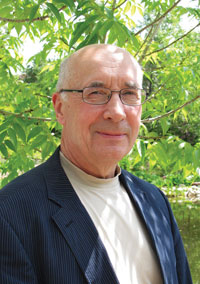Saskatchewan has the infrastructure and research expertise to make things happen. Worldwide, there is no question: bioscience innovation is needed. There will be more people on the planet and many will enjoy rising incomes. The amount of arable land is decreasing; many resources are less plentiful or more expensive to extract; added to this are challenges presented by climate change. Bioscience innovations will be essential to feed populations and fuel the need for transportation, energy and industrial material
Saskatchewan’s bioeconomy is poised for sustainable long term growth. While attracting investment may be a challenge, there exists in Saskatchewan an enviable mix of capacity spread throughout industry, government and universities.s – in a way that is more sustainable and friendly to the environment. Already a Canadian bioscience leader, Saskatchewan is poised to become a bright spot for innovation.
When biotech boomed in the early 1990s and early 2000s, a genetics professor with a new discovery could expect millions from investors eager to be part of the next big thing. Those days are pretty much past, says David Gauthier, CEO of the Entrepreneurial Foundation of Saskatchewan. “Getting to cash flow is a huge challenge because private equity has moved to later-stage deals. Investors know it’s harder to make money during early stages. It takes a long time and there’s a high failure rate,” says Gauthier, whose organization advises entrepreneurs seeking financing to grow, transition or reach stability.
 Gauthier’s background gives him unique insight into the ups and downs of bio-business. With a Biology PhD and an MBA, Gauthier once managed a national venture capital fund specializing in agricultural science. He moved to Saskatoon in 2005 to become Regional Director of National Research Council’s (NRC) Industrial Research Assistance Program.
Gauthier’s background gives him unique insight into the ups and downs of bio-business. With a Biology PhD and an MBA, Gauthier once managed a national venture capital fund specializing in agricultural science. He moved to Saskatoon in 2005 to become Regional Director of National Research Council’s (NRC) Industrial Research Assistance Program.
Gauthier believes biobusiness has a bright future and Saskatchewan will play a leading role. “The good thing is that because of new research technologies, genomics, screening, marker assisted breeding, we have more capabilities on the research side. We also have more diverse biotech companies in the province using molecular and biotech tools to support different business models,” Gauthier says.
Saskatchewan’s traditional strengths as an agricultural centre also play a role, says Jerome Konecsni, Director General of NRC’s Plant Biotechnology Institute. “Saskatchewan has many advantages, including 40 per cent of Canada’s arable land. We have skilled producers and a good distribution system,” Konecsni says. Add to the mix a healthy business atmosphere and one of the lowest tax rates for manufacturers, and the province is more than competitive. But Konecsni notes that skilled personnel are still needed on the processing side of the equation. “I believe we’re on the right track. The province has identified three pillars for innovation strategy, based on natural advantages. Encouraging more industrial investment is an important part of the plan,” he says. Konecsni was recently appointed CEO of Innovation Saskatchewan, assuming his new position at the end of September.
 Mary Buhr is also confident about Saskatchewan’s role in the future bioscience world. Buhr is Dean of the University of Saskatchewan’s College of Agriculture and Bioresources, moving from Guelph in 2009 to take the helm at U of S AgBio.
Mary Buhr is also confident about Saskatchewan’s role in the future bioscience world. Buhr is Dean of the University of Saskatchewan’s College of Agriculture and Bioresources, moving from Guelph in 2009 to take the helm at U of S AgBio.
“One of the things that blew me away when I got here, was how incredibly effective and functional the research community is here. There is a lot of collaboration whether you’re
Our research park in Saskatoon, and this extends to Regina as well, is second to none in Canada. Where else can you find facilities like the Canadian Light Source, VIDO-Intervac, a nuclear industry, Agriculture and Agri-Food Canada and various federal and provincial facilities, and generally a sense of optimism from people who work in the sector.”from the corporate world, university or government,” Buhr says. “We still tend to be people who sell raw- or lightly-processed material for export, and leave the fine details to be done elsewhere. We can’t limit ourselves to developing great ideas yet having the products created somewhere else. We lose out.”What needs to improve, says Buhr, is the actual number of companies “on the ground” bringing research and knowledge to commercial markets.
Need for bio
With plentiful natural resources increasingly in demand, some might think Saskatchewan could enjoy prosperity just relying on its natural bounty. But that would be a mistake, says Peter Phillips, Professor, Johnson-Shoyama Graduate School of Public Policy at the U of S.
 “This is probably the third commodity cycle I’ve seen during my professional career – what goes up, does come down,” cautions Phillips. “Having a resource is not enough in the 21st century. And the value that can be added to something, whether it’s a pound of potash or uranium or canola, the bulk of that value isn’t in the resource or even the land and capital infrastructure. The bulk of that value is knowledge, and knowledge is very fluid.” That means a continued investment in creating and sustaining knowledge, and attracting and using the people who create this intellectual capital, says Phillips.
“This is probably the third commodity cycle I’ve seen during my professional career – what goes up, does come down,” cautions Phillips. “Having a resource is not enough in the 21st century. And the value that can be added to something, whether it’s a pound of potash or uranium or canola, the bulk of that value isn’t in the resource or even the land and capital infrastructure. The bulk of that value is knowledge, and knowledge is very fluid.” That means a continued investment in creating and sustaining knowledge, and attracting and using the people who create this intellectual capital, says Phillips.
Proof of the concept, he notes, lies in the value now being realized because of strategic investment in Saskatchewan’s agrifood cluster in decades past.
“If you look at Canada, every province used to have an agriculture college and federal laboratory. Many now do not. Saskatoon is now extremely competitive because it has these things – if you’re a firm looking to do basic research and adapt technologies and products to new production and supply chains, it’s not like there are hundreds of candidate cities,” Phillips says.
Ag-West Bio could be considered one of those early investments, and Wilf Keller, the organization’s President and CEO says it is essential that the public and policy makers understand the potential role of bioscience in economic and human health terms.
 “Bioscience is really coming to the fore. You can think of it as the threshold of another era of science. Some people liken it to the computer industry,” Keller says.
“Bioscience is really coming to the fore. You can think of it as the threshold of another era of science. Some people liken it to the computer industry,” Keller says.
It’s a new era, with the potential for developing new genetic strains in crops and livestock, ensuring adequate food as the climate changes, and allowing a better understanding of the role of food and food ingredients in human health, says Keller. Bioscience will provide new methods of diagnosing or preventing disease, and healthier ways of creating renewable energy and bioproducts, such as plastics and lubricants.
“Our environment, our economy and our health; these are things that matter to all of us.”
Written for the Ag-West Bio 2010-2011 Annual Report.